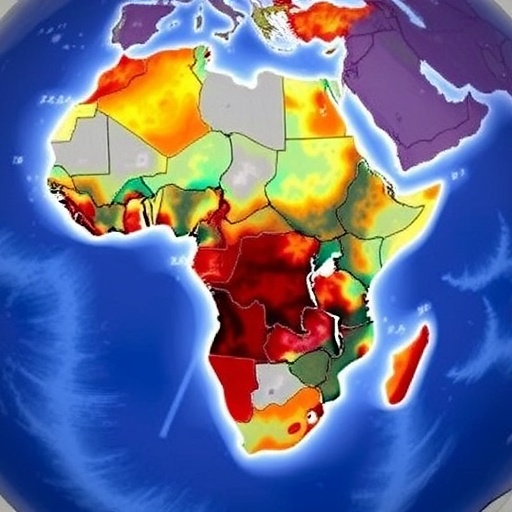
In an era where forensic science continually advances, the accurate estimation of population affinity has emerged as a critical component in forensic anthropology. A groundbreaking study authored by Mbonani, L’Abbé, Chen, and colleagues brings to the forefront the intricate challenges and unique considerations of population affinity estimation within the South African context. As forensic experts grapple with increasingly diverse and complex demographic landscapes, this research offers invaluable insights, blending advanced methodological approaches with a culturally nuanced understanding that could revolutionize identification processes globally.
Population affinity estimation—often misunderstood as mere racial classification—plays a nuanced and vital role in forensic anthropology. It involves the estimation of the ancestral or population origin of skeletal remains based on morphological traits, genetic markers, and sometimes contextual data. The South African perspective provided by this study underscores the necessity of tailored approaches that respect the continent’s rich, multifaceted demographic complexity. Fundamental to this research is the recognition that traditional models, often developed on Eurocentric or North American datasets, may be inadequate or misleading when applied without adaptation to African populations.
The research highlights the intrinsic biological diversity of the South African population, which is characterized by multiple ethno-linguistic groups with overlapping phenotypic and genotypic characteristics. This diversity challenges the forensic anthropologist’s ability to accurately assign population affinity when working with fragmented or incomplete remains. Mbonani and colleagues argue convincingly for population-specific reference collections, sophisticated statistical models, and interdisciplinary collaboration that integrate archaeological records, historic migration patterns, and genetic data to improve identification accuracy.
.adsslot_M08f79iPWV{width:728px !important;height:90px !important;}
@media(max-width:1199px){ .adsslot_M08f79iPWV{width:468px !important;height:60px !important;}
}
@media(max-width:767px){ .adsslot_M08f79iPWV{width:320px !important;height:50px !important;}
}
ADVERTISEMENT
One of the most significant technical advancements discussed involves the application of geometric morphometrics—an innovative technique that quantifies shape variations of skeletal elements with greater precision than traditional metrics. This method leverages three-dimensional imaging and landmark-based analyses, providing a window into subtle morphological differences that can correlate with population affinity. The adoption of such methods in South Africa’s forensic investigations promises enhanced discrimination power, enabling practitioners to distinguish between closely related groups with improved confidence.
Genetic analysis also features prominently in this work, with the authors advocating for the combination of phenotypic assessments and molecular data. Using high-throughput sequencing technologies to analyze ancient and modern DNA samples, researchers can detect lineage-specific markers that complement skeletal evaluations. This integrative approach is particularly vital in South Africa, where diverse ancestral contributions—including indigenous African populations, European settlers, and Asian migrants—create complex admixture patterns.
The researchers emphasize the ethical dimensions inherent to forensic anthropology in the South African milieu. They contend that population affinity estimation must be conducted with cultural sensitivity and respect for the communities involved, especially when working with human remains. Transparent communication, collaborative partnerships with local groups, and adherence to legal frameworks underpin the responsible application of forensic methods, ensuring that scientific rigor does not come at the expense of social justice.
Beyond the technical advancements, the study explores the broader forensic implications of population affinity estimation. In criminal investigations, accurate ancestry estimation can significantly narrow down unidentified remains’ profiles, expediting the process of finding matches in missing persons databases. This utility extends to mass disaster scenarios and historical cases, where demographic insights can be pivotal in reconstructing identities in contexts ranging from apartheid-era violence to contemporary conflicts.
One of the unique aspects of the South African context discussed by the authors is the legal-medical interface, where the forensic anthropologist’s findings intersect with judicial processes. The precision and cultural appropriateness of population affinity assessments directly impact case outcomes and the administration of justice. This necessitates continuous training for forensic practitioners and the refinement of protocols that align with South Africa’s diverse population structure and evolving legal standards.
The authors also detail the challenges posed by skeletal preservation and decomposition rates under various South African environmental conditions. Climatic factors such as humidity, soil acidity, and temperature fluctuations influence the degradation of biological tissues and impact the reliability of morphological and genetic analyses. The study calls for environmental data integration within forensic frameworks to account for these variables during affinity estimation.
Importantly, the research cautions against simplistic or deterministic interpretations of population affinity, advocating instead for probabilistic models that express findings with confidence intervals and uncertainty metrics. This approach reflects a sophisticated understanding of human variation and avoids reinforcing stereotypes or perpetuating biases, which have historically marred forensic and anthropological sciences.
The implications of this work extend internationally, offering a template for other regions grappling with similarly complex demographic backgrounds. The South African perspective serves as a case study demonstrating how forensic anthropology can evolve beyond outdated paradigms, embracing technological innovation and multidisciplinary perspectives to address the global need for accurate population affinity estimation.
Furthermore, the study’s innovative methodological framework includes machine learning algorithms trained on South African skeletal datasets, which automate and enhance classification performance. These computational models, validated with rigorous cross-validation techniques, offer promising avenues for reducing human error and bias—issues that have long hindered forensic anthropology’s objectivity and reproducibility.
Collaborations between forensic anthropologists, geneticists, statisticians, and local communities featured prominently in the research, highlighting the importance of interdisciplinary synergy. These networks facilitate knowledge exchange, resource sharing, and the establishment of expansive, representative skeletal repositories essential for ongoing research and forensic applications.
Mbonani and colleagues’ work also addresses the educational gaps within the forensic field in South Africa, advocating for updated curricula that incorporate contemporary techniques and ethical considerations related to population affinity estimation. This recommendation aims at ensuring a new generation of forensic scientists is well equipped to confront the challenges posed by increasingly heterogeneous populations.
As forensic anthropology continues to advance amid rapid technological progress, the South African perspective articulated in this research embodies an essential shift toward inclusivity, precision, and contextual awareness. This study not only sets a new standard for forensic population affinity estimations but also sparks vital conversations about science, identity, and justice in a diverse world.
In conclusion, the comprehensive approach undertaken by Mbonani, L’Abbé, Chen, and their team transcends conventional forensic anthropology by integrating cutting-edge technologies, region-specific data, and ethical imperatives. Their work elevates the practice of population affinity estimation in South Africa and offers profound lessons for the global forensic community striving to balance scientific inquiry with cultural respect.
Article Title:
Population affinity estimation in forensic anthropology: a South African perspective
Article References:
Mbonani, T., L’Abbé, E., Chen, DG. et al. Population affinity estimation in forensic anthropology: a South African perspective. Int J Legal Med (2025). https://doi.org/10.1007/s00414-025-03529-8
Image Credits: AI Generated
Tags: advanced forensic methodologiesancestral origin estimation in anthropologybiological diversity in South Africachallenges in forensic identificationcontextual data in forensic anthropologycultural considerations in forensicsdemographic complexity in forensic scienceethno-linguistic groups in forensicsEurocentric models in anthropologyforensic anthropology in South Africagenetic markers in population studiespopulation affinity estimation methods





